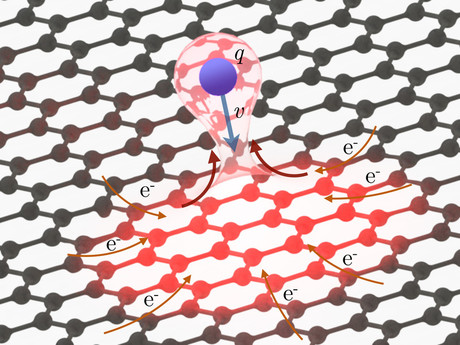High currents can pass through graphene

European researchers have discovered that electrons in graphene are extremely mobile and react very quickly, enabling high currents to pass through the substance and allowing imbalances in electric charge to be rapidly rectified.
In an experiment led by Professor Fritz Aumayr from TU Wien, the researchers worked with extremely highly charged xenon ions. These ions were fired at a freestanding single layer of graphene, which was clamped between microscopically small brackets. The results were published in the journal Nature Communications.
The xenon ions impacted the graphene film in a very precise spot, causing a large number of electrons to be torn away. However, the material was able to replace these electrons within femtoseconds. This resulted in extremely high currents, which would not be maintained under normal circumstances.
“The xenon ion penetrates the graphene film, thereby knocking a carbon atom out of the graphene — but that has very little effect, as the gap that has opened up in the graphene is then refilled with another carbon atom,” explained TU Wien PhD student Elisabeth Gruber. “For us, what is much more interesting is how the electrical field of the highly charged ion affects the electrons in the graphene film.”

As the highly charged ion approaches the film, it starts tearing electrons away from the graphene due to its extremely strong electric field. By the time the ion has fully passed through the graphene layer, it has a positive charge of less than 10, compared to over 30 when it started out. The ion is able to extract more than 20 electrons from a tiny area of the graphene film. This means that electrons are now missing from the graphene layer, so the carbon atoms surrounding the point of impact of the xenon ions are positively charged.
“What you would expect to happen now is for these positively charged carbon ions to repel one another, flying off in what is called a Coulomb explosion and leaving a large gap in the material,” said Richard Wilhelm from the Helmholtz-Zentrum Dresden-Rossendorf.
“But astoundingly, that is not the case. The positive charge in the graphene is neutralised almost instantaneously.” This is only possible because a sufficient number of electrons can be replaced in the graphene within an extremely short time frame of several femtoseconds.
“The electronic response of the material to the disruption caused by the xenon ion is extremely rapid,” said Gruber. “Strong currents from neighbouring regions of the graphene film promptly resupply electrons before an explosion is caused by the positive charges repelling one another.
“The current density is around 1000 times higher than that which would lead to the destruction of the material under normal circumstances — but over these distances and time scales, graphene can withstand such extreme currents without suffering any damage.”
Graphene’s high electron mobility is of great significance for a number of potential applications, particularly ultrafast electronics. “Graphene also appears to be excellently suited for use in optics, for example in connecting optical and electronic components,” said Professor Aumayr.
Avoiding EMC issues: simple tests you can do yourself
This is a brief overview of EMC compliance with some practical tips on not getting caught out.
Electric dump valves help oil and gas company reduce emissions
Oil and gas company Laramie Energy deployed ASCO zero-emissions electric dump valves to comply...
Australia's largest electronics expo returns to Sydney
Electronex, the annual electronics design and assembly expo, will return to Sydney on 19–20...





